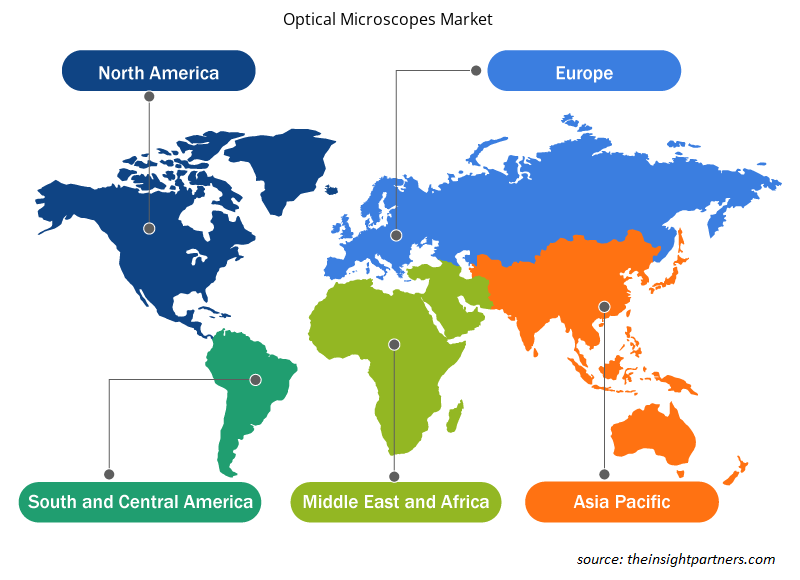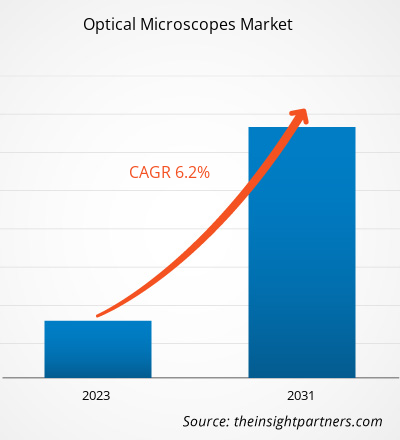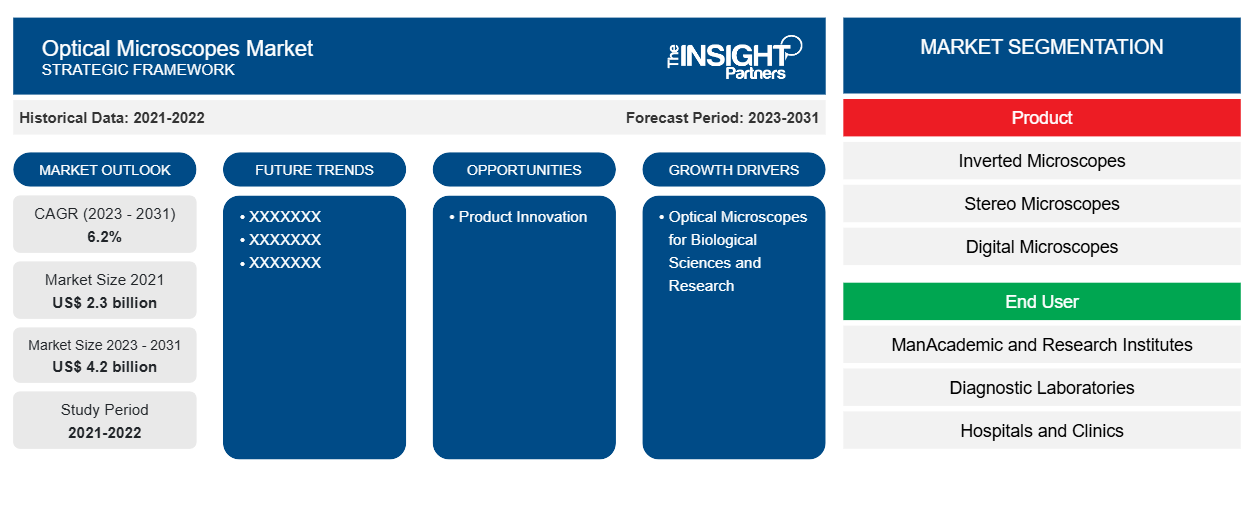Der Markt für optische Mikroskope wurde im Jahr 2021 auf 2,3 Milliarden US-Dollar geschätzt und soll bis 2031 4,2 Milliarden US-Dollar erreichen. Von 2023 bis 2031 wird für den Markt eine durchschnittliche jährliche Wachstumsrate (CAGR) von 6,2 % erwartet.
Technologische Fortschritte und strategische Allianzen auf dem Markt werden voraussichtlich weiterhin die wichtigsten Trends auf dem Markt für optische Mikroskope bleiben.
Optische Mikroskope Marktanalyse
Optische Mikroskope für Biowissenschaften und Forschung
Fortschritte in den Biowissenschaften sind mit optischen Mikroskopen verbunden. Mit einem optischen Mikroskop können eukaryotische Zellen einschließlich Kernen, Mitochondrien und Chloroplasten beobachtet werden. Darüber hinaus verfügen optische Mikroskope über sichtbare elektromagnetische Strahlung für verschiedene Bildgebungsanwendungen in den Bereichen Zellbiologie, Biotechnologie, Biowissenschaften, Nanotechnologie und die Untersuchung histopathologischer Gewebeschnitte für die klinische Diagnose. Darüber hinaus entwickeln Hersteller innovative optische Mikroskope mit hoher Vergrößerung und besserer Visualisierung biologischer Proben. McConnells neuartige optische Mikroskope zur Abbildung großer Embryonen und Zellgewebe durch die „subzelluläre Auflösung“ optischer Mikroskope sind ein bemerkenswertes Beispiel. Daher sind Fortschritte bei optischen Mikroskopen mit besserer Bildgebung für die Biowissenschaften und Forschung, um den klinischen Bedürfnissen der Patienten gerecht zu werden, einer der einflussreichsten Faktoren für das Marktwachstum.
Marktübersicht für optische Mikroskope
Technologie, Innovation und intelligente technologische Lösungen beeinflussen den Markt für optische Mikroskope weiterhin erheblich. Optische Mikroskope für Biowissenschaften und Forschung sowie hohe Vergrößerungs- und Auflösungsraten optischer Mikroskope sind die einflussreichsten Faktoren für das Wachstum des Marktes für optische Mikroskope. Fortschritte bei optischen Mikroskopprodukten sind ein wichtiger Trend für das Wachstum des Marktes für optische Mikroskope. Produktinnovationen bieten lukrative Marktchancen für das Wachstum des Marktes für optische Mikroskope.
Passen Sie diesen Bericht Ihren Anforderungen an
Sie erhalten kostenlos individuelle Anpassungen an jedem Bericht, einschließlich Teilen dieses Berichts oder einer Analyse auf Länderebene, eines Excel-Datenpakets sowie tolle Angebote und Rabatte für Start-ups und Universitäten.
-
Holen Sie sich die wichtigsten Markttrends aus diesem Bericht.Dieses KOSTENLOSE Beispiel umfasst eine Datenanalyse von Markttrends bis hin zu Schätzungen und Prognosen.
Markttreiber und Chancen für optische Mikroskope
Einführung optischer Mikroskope mit hoher Vergrößerung und Auflösung zur Förderung des Marktes
Seit zwei Jahrzehnten haben Wissenschaftler entdeckt, dass sich mit optischen Mikroskopen Objekte erkennen, verfolgen und lokalisieren lassen. Heute jedoch ermöglicht die Forschungsabteilung des National Institutes of Standards and Technology (NIST) Mikroskopen, Details im Nanometerbereich (NM) mit hoher Genauigkeit zu messen. So entwickelte das NIST beispielsweise ein neues Kalibrierungsverfahren, das Bildfehler genau untersucht und korrigiert. Die bahnbrechende Forschung wurde 2014 mit dem Nobelpreis für Chemie ausgezeichnet. Sie ermöglichte es Forschern, Proteine in befruchteten Eiern zu verfolgen, Moleküle zu visualisieren, die elektrische Verbindungen zwischen Nervenzellen im Gehirn bilden, und die Bewegung von Miniaturmotoren im Nanobereich zu untersuchen. Daher werden hohe Vergrößerungen und Auflösungen optischer Mikroskope das Marktwachstum erheblich vorantreiben.
Produktinnovation – eine Chance
Die optische Mikroskopie ist ein hochentwickeltes Mikroskop, das den Fortschritt in der Zellbiologie vorantreibt, um eine räumliche und zeitliche Auflösung zu erreichen, die zur Erkennung lebender Zellen und Gewebe erforderlich ist. Seit jeher ist das Färben von Proben mit fluoreszierenden Markierungen eine hochempfindliche Methode zur Visualisierung von Biomolekülen. Die Fluoreszenzmikroskopie ist jedoch mit mehreren Einschränkungen verbunden, die mit dem Färben von Proben verbunden sind, wie Probenmanipulation und Färbeartefakte, Fluorophor-Photobleichung und damit verbundene Phototoxizität. Daher haben die Forscher große Anstrengungen unternommen, um markierungsfreie optische Mikroskopietechniken zu entwickeln, die in der Lage sind, quantitative Fähigkeiten in optischen Mikroskopen bereitzustellen, die mit Fluoreszenzmikroskopen bisher nicht verfügbar waren. Beispielsweise entwickeln die Labore quantitative markierungsfreie optische Mikroskope mit innovativen Anregungs-/Erkennungsschemata für verschiedene Anwendungen, um synthetische Lipidmembranen und Nanopartikelmaterialien lebender Zellen zu erkennen. Außerdem entwickeln Forschungslabore eine neue Methode der interferometrischen Weitfeldreflektometrie, um die Wechselwirkungen einzelner Proteinlipidmembranen mit beispielloser Empfindlichkeit zu überwachen. Daher werden innovative Produktinnovationen in den kommenden Jahren lukrative Marktchancen für den Markt für optische Mikroskope bieten.
Segmentierungsanalyse des Marktberichts für optische Mikroskope
Wichtige Segmente, die zur Ableitung der Marktanalyse für optische Mikroskope beigetragen haben, sind Bewerbung und Dienstleistungen.
- Basierend auf dem Produkt ist der Markt für optische Mikroskope in inverse Mikroskope, Stereomikroskope, digitale Mikroskope und Zubehör unterteilt. Das Segment der inversen Mikroskope könnte im Jahr 2023 einen größeren Marktanteil halten.
- Nach Endverbraucher ist der Markt in akademische und Forschungsinstitute, Diagnoselabore, Krankenhäuser und Kliniken sowie Pharma- und Biotechnologieunternehmen unterteilt. Das Segment der akademischen und Forschungsinstitute könnte im Jahr 2023 den größten Marktanteil halten.
Optische Mikroskope Marktanteilsanalyse nach Geografie
Der geografische Umfang des Marktberichts für optische Mikroskope ist hauptsächlich in fünf Regionen unterteilt: Nordamerika, Asien-Pazifik, Europa, Naher Osten und Afrika sowie Südamerika/Süd- und Mittelamerika.
Nordamerika dominiert den Markt für optische Mikroskope. In Nordamerika haben die USA einen beträchtlichen Anteil an optischen Mikroskopen. Die Präsenz führender Medizintechnikunternehmen in den USA und technologisch fortschrittliche Produkte sind die einflussreichsten Faktoren für das Marktwachstum. Der asiatisch-pazifische Raum wird in den kommenden Jahren voraussichtlich die höchste durchschnittliche jährliche Wachstumsrate aufweisen.
Regionale Einblicke in den Markt für optische Mikroskope
Die regionalen Trends und Faktoren, die den Markt für optische Mikroskope im Prognosezeitraum beeinflussen, wurden von den Analysten von Insight Partners ausführlich erläutert. In diesem Abschnitt werden auch die Marktsegmente und die Geografie für optische Mikroskope in Nordamerika, Europa, im asiatisch-pazifischen Raum, im Nahen Osten und Afrika sowie in Süd- und Mittelamerika erörtert.

- Erhalten Sie regionale Daten zum Markt für optische Mikroskope
Umfang des Marktberichts über optische Mikroskope
| Berichtsattribut | Details |
|---|---|
| Marktgröße im Jahr 2021 | 2,3 Milliarden US-Dollar |
| Marktgröße bis 2031 | 4,2 Milliarden US-Dollar |
| Globale CAGR (2023 - 2031) | 6,2 % |
| Historische Daten | 2021-2022 |
| Prognosezeitraum | 2023–2031 |
| Abgedeckte Segmente |
Nach Produkt
|
| Abgedeckte Regionen und Länder |
Nordamerika
|
| Marktführer und wichtige Unternehmensprofile |
|
Dichte der Marktteilnehmer für optische Mikroskope: Auswirkungen auf die Geschäftsdynamik verstehen
Der Markt für optische Mikroskope wächst rasant, angetrieben durch die steigende Nachfrage der Endnutzer aufgrund von Faktoren wie sich entwickelnden Verbraucherpräferenzen, technologischen Fortschritten und einem größeren Bewusstsein für die Vorteile des Produkts. Mit steigender Nachfrage erweitern Unternehmen ihr Angebot, entwickeln Innovationen, um die Bedürfnisse der Verbraucher zu erfüllen, und nutzen neue Trends, was das Marktwachstum weiter ankurbelt.
Die Marktteilnehmerdichte bezieht sich auf die Verteilung von Firmen oder Unternehmen, die in einem bestimmten Markt oder einer bestimmten Branche tätig sind. Sie gibt an, wie viele Wettbewerber (Marktteilnehmer) in einem bestimmten Marktraum im Verhältnis zu seiner Größe oder seinem gesamten Marktwert präsent sind.
Die wichtigsten auf dem Markt für optische Mikroskope tätigen Unternehmen sind:
- Nikon Corporation
- Carl Zeiss AG
- Agilent Technologies, Inc.
- Bruker
- Olympus Corporation
- Leica Microsystems
Haftungsausschluss : Die oben aufgeführten Unternehmen sind nicht in einer bestimmten Reihenfolge aufgeführt.

- Überblick über die wichtigsten Akteure auf dem Markt für optische Mikroskope
Marktnachrichten und aktuelle Entwicklungen zu optischen Mikroskopen
Der Markt für optische Mikroskope wird durch die Erhebung qualitativer und quantitativer Daten nach Primär- und Sekundärforschung bewertet, die wichtige Unternehmensveröffentlichungen, Verbandsdaten und Datenbanken umfasst. Im Folgenden finden Sie eine Liste der Entwicklungen auf dem Markt für optische Mikroskope und Strategien:
- Im April 2023 kündigte die Nikon Corporation (Nikon) die Entwicklung und Markteinführung des digitalen Bildmikroskops „ECLIPSE Ui“ als erstes Mikroskop für den medizinischen Einsatz in Japan an. ECLIPSE Ui verfügt über ein einzigartiges Design ohne Okularlinse, das die Beobachtungshaltung des Pathologen verbessert und das Teilen von Beobachtungsbildern auf dem Display ermöglicht. Das Mikroskop trägt dazu bei, die körperliche Belastung des Pathologen zu verringern und den Arbeitsablauf pathologischer Beobachtungen zu verbessern.
Marktbericht zu optischen Mikroskopen – Umfang und Ergebnisse
Der Bericht „Marktgröße und Prognose für optische Mikroskope (2021–2031)“ bietet eine detaillierte Analyse des Marktes, die die folgenden Bereiche abdeckt:
- Marktgröße und Prognose auf globaler, regionaler und Länderebene für alle wichtigen Marktsegmente, die im Rahmen des Projekts abgedeckt sind
- Marktdynamik wie Treiber, Beschränkungen und wichtige Chancen
- Wichtige Zukunftstrends
- Detaillierte PEST/Porters Five Forces- und SWOT-Analyse
- Globale und regionale Marktanalyse mit wichtigen Markttrends, wichtigen Akteuren, Vorschriften und aktuellen Marktentwicklungen
- Branchenlandschaft und Wettbewerbsanalyse, einschließlich Marktkonzentration, Heatmap-Analyse, prominenten Akteuren und aktuellen Entwicklungen
- Detaillierte Firmenprofile
- Historische Analyse (2 Jahre), Basisjahr, Prognose (7 Jahre) mit CAGR
- PEST- und SWOT-Analyse
- Marktgröße Wert/Volumen – Global, Regional, Land
- Branchen- und Wettbewerbslandschaft
- Excel-Datensatz
Aktuelle Berichte
Verwandte Berichte
Erfahrungsberichte
Grund zum Kauf
- Fundierte Entscheidungsfindung
- Marktdynamik verstehen
- Wettbewerbsanalyse
- Kundeneinblicke
- Marktprognosen
- Risikominimierung
- Strategische Planung
- Investitionsbegründung
- Identifizierung neuer Märkte
- Verbesserung von Marketingstrategien
- Steigerung der Betriebseffizienz
- Anpassung an regulatorische Trends























 Kostenlose Probe anfordern für - Markt für optische Mikroskope
Kostenlose Probe anfordern für - Markt für optische Mikroskope